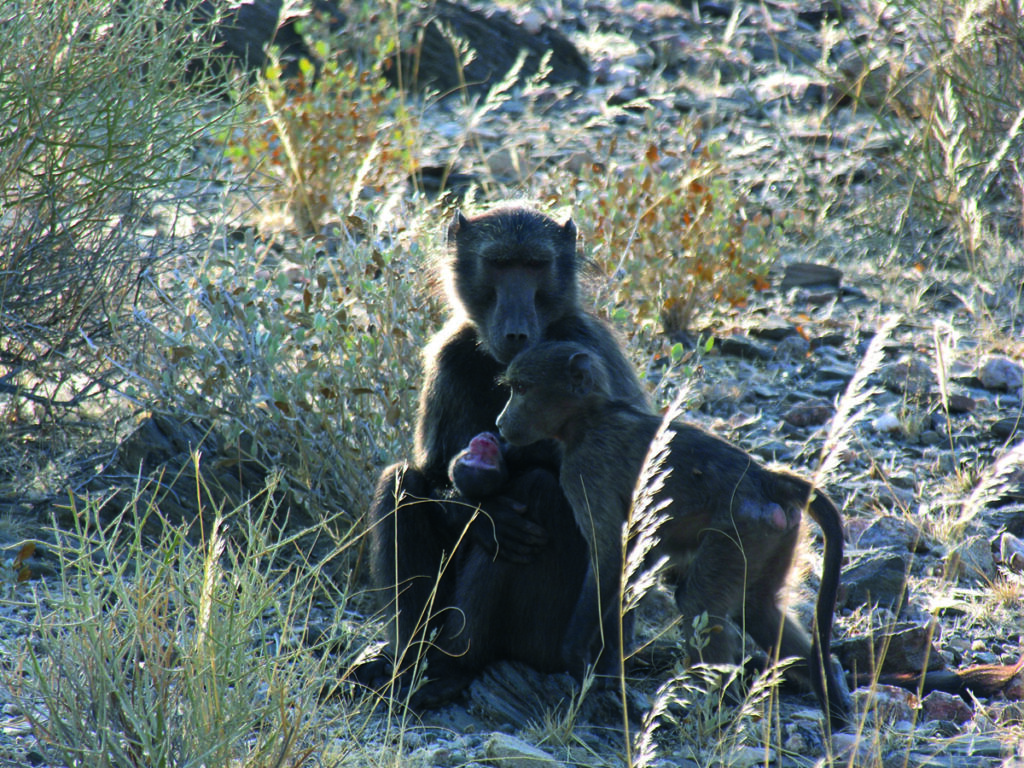[LUM#14] Watching the mourning of chacma baboons
Grief does not stop at the threshold of human life. Numerous studies have reported on the emotional and physiological manifestations provoked by the death of a loved one in animals. This is illustrated in Namibia, where Montpellier primatologist Elise Huchard explores how female baboons mourn the death of their young.

The expression "mourning" could have been invented for them. In the Tsaobis nature park, at the gateway to the Namib desert, female chacma baboons have been observed carrying the small corpse of their dead baby for several days. Carrying is very difficult for them," explains Elise Huchard, primatologist at theInstitut des sciences de l'évolution de Montpellier (Isem*). A living baby will cling to its mother's belly or back on its own, but they have to carry it either in their mouths, or support it permanently with one arm, which makes it very difficult for them to move around".
Grieving with both hands
For these baboons, forced to travel great distances every day to feed, the cost of such behavior is significant. Yet the females will sometimes carry the body for a week, or even ten days. "They put it down for a bit to go and eat, but as soon as another individual approaches, they hurry back. Sometimes they lose it during a social conflict, for example. In such cases, we've heard females emit distress calls," says the ethologist.
Continued grooming is another sign of mourning, even when, under the effect of heat, the small body appears totally mummified or dislocated. Or again, the examination of the wounds that caused death, most often inflicted by a male: "In the first hours of death, we often see the females put their finger in the wound, licking it. We've seen them remove debris from the baby's mouth. According to the researcher, these manifestations "very probably" testify to the strength of the social bond between a primate mother and her young. " When there's a sudden, unexpected break in this bond, mothers can't deal with it emotionally. Staying in touch with their child's body can help them cope."
Researchers do not rule out the possibility that the death of adult individuals may also trigger expressions of grief, although these are more difficult to observe, particularly as corpses are not found. Another study on baboons nevertheless revealed, through analysis of cortisol levels in feces, an increase in stress levels in females who had just lost a friend. This is one of the few studies to quantify a physiological stress reaction to the death of a loved one," explains Elise Huchard. These females will then have more grooming partners than usual, which helps them to recover their usual stress hormone levels more quickly."
The field of mourning
Because of their very nature, mourning in animals in general remains a relatively unexplored subject. Rare and unpredictable, death and the reactions it provokes can hardly be the subject of a specific project, as the behaviorist points out: "For a long time, we recorded these behaviors in the context of our routine projects. Then, in the 2010s, a field of research emerged on reactions to death in animals, which has been particularly flourishing in primates."
A field that Elise Huchard and her colleagues from the Tsaobis baboon project hope to expand by using this study as the kick-off for a truly long-term project devoted to the observation of mourning in baboons. Their aim: to set up a protocol for quantifying all these behaviors over several years. "We'd like to know what impact mourning can have on the lives of these females. Will they withdraw socially or, on the contrary, be more social? Will they seek consolation or social compensation from other individuals in the group? Will they eat less? Does the intensity of the maternal relationship influence the duration of mourning?
With a heavy heart...
But are primates the only social mammals to express a reaction to death? For Elise Huchard, the answer is no. "Typically, in the case of primates, we have this flagrant carrying behavior, which is a consequence of the fact that they have hands. There's also a longer developmental period in these species, which explains the strength of the mother-child bond, but I think many animals react to death with more or less obvious manifestations." He cites the case of whales ororcas remaining in contact for several days with the corpse of their young, orelephants returning for months at a time to the site of a loved one's death.
At the end of these observations, one question inevitably comes to mind: isn't this proof that animals are aware of death? Not so simple, according to the specialist, for whom the fact of mourning "does not necessarily imply a high level of awareness of death, but this is partly the field of philosophers, and their contribution to concepts as difficult to manipulate as consciousness is extremely valuable for scientists like us". One thing is certain: these baboons don't ape their grief.
UM podcasts are now available on your favorite platforms (Spotify, Deezer, Apple podcasts, Amazon Music...).
* Isem (UM - CNRS - IRD - EPHE)